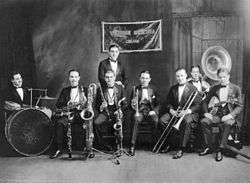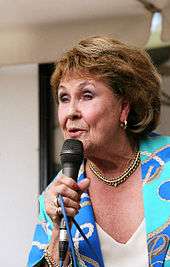1924 in jazz
| 1924 in jazz | |
|---|---|
 The Wolverines with Bix Beiderbecke at Doyle's Academy of Music in Cincinnati, Ohio in 1924. | |
| Decade | 1920s in jazz |
| Music | 1924 in music |
| Standards | List of 1920s jazz standards |
| See also | 1923 in jazz – 1925 in jazz |
| |||
|---|---|---|---|
This is a timeline documenting events of Jazz in the year 1924.
Musicians born that year included the drummer Max Roach and singers Sarah Vaughan and Dinah Washington. In 1924, Leopold Stokowski, the British orchestral conductor of the Philadelphia Orchestra, observed that jazz had "come to stay."[1]
Jazz scene
In 1924 the improvised solo had become an integral part of most jazz performances[2]
Jazz was becoming increasingly popular in New Orleans, Kansas City, Chicago and New York City and 1924 was something of a benchmark of jazz being seen as a serious musical form.[3][4] John Alden Carpenter made a statement insisting that jazz was now 'our contemporary popular music',[5] and Irving Berlin made a statement that jazz was the "rhythmic beat of our everyday lives," and the music's "swiftness is interpretive of our verve and speed". Leopold Stokowski, the conductor of the Philadelphia Orchestra in 1924, publicly embraced jazz as a musical art form and delivered praise to various jazz musicians.[6] In 1924, George Gershwin wrote Rhapsody in Blue, widely regarded as one of the finest compositions of the 20th century;[7] saying he conceived it "as a sort of musical kaleidoscope of America–of our vast melting pot, of our incomparable national pep, our blues, our metropolitan madness."[8]
Black jazz entrepreneur and producer Clarence Williams successfully recorded groups in the New Orleans area, amongst them Sidney Bechet and Louis Armstrong.[2] Williams, like Armstrong soon moved from New Orleans and opened a record store in Chicago. In Chicago, Earl Hines formed a group and incidentally inhabited the neighboring apartment to Armstrong whilst he was in Chicago.[9] Also in Chicago, trumpeter Tommy Ladnier begins playing in Joe Oliver's band. Meanwhile, Bechet soon moved to New England with Ellington during the summer of 1924, playing dances and later New York City.
While in 1924 in jazz, ensembles in the Kansas City area began play a style with a four even beat ground beat as opposed to a New Orleans two beat ground beat behind a 4/4 melody,[9] European jazz included a fox trot by the Swiss composer Frank Martin for the Marionette Theatre in Paris.[10]
Charlie Parker grew up in Kansas City listening to this style of jazz. In 1924, Django Reinhardt became a guitarist and began playing the clubs of Paris.[9] Noted Classic Blues singer Bessie Smith began to achieve major fame.[9]
Events
- 5 February: Louis Armstrong marries pianist and composer Lil Hardin.[9]
- 12 February: Paul Whiteman brings jazz to the concert stage, at Aeolian Hall in New York City. The concert includes such jazz tunes as Livery Stable Blues, and was the premier of George Gershwin's Rhapsody in Blue.[11] According to jazz historian Marshall Stearns, "Paul Whiteman made jazz semi-respectable in 1924."[12]
- 18 February: A 20-year old Bix Beiderbecke (cornet), Min Lelbrook (tuba), Jimmy Hartwell (clarinet), George Johnson (tenor sax), Bob Gilette (banjo), Vic Moore (drums), Dick Voynow (piano) and Al Gandee (trombone) form The Wolverines and make their first recording at the Gennett studios in Richmond, Indiana with Fidgety Feet.[9]
- June: Armstrong quits the Oliver band upon the request of his wife much to his dismay and is later rejected by Sammy Steward because he "wasn't dicty enough".[9]
- July: Meyer Davis was reportedly offered a hundred dollars to come up with a new name for "jazz". Concern over the name disappeared by the end of 1924 and did not resurface until 1949 when Down Beat Magazine ran a $1000 contest in the searching for a new name, remarking that the name "jazz" had lost all significance.[13]
- 30 September: Louis Armstrong, having left King Oliver's band in Chicago to be replaced by Lee Collins, arrives in New York City.[9][14]
- October: Armstrong joins Fletcher Henderson's band in New York City upon his wife's insistence. They begin performing at the Roseland Ballroom on 51st street and Broadway in Manhattan.[9] His new style of jazz playing greatly influences the style of other New York musicians such as Coleman Hawkins and Duke Ellington.[15] Ellington and his Washingtonians perform at the Hollywood Club on 49th street and Broadway, whilst Bix Beiderbecke and the Wolverines, renamed Personality Kids perform at the Cinderella Ballroom on 41st street and Broadway. Hoagy Carmichael is much impressed by Beiderbecke and the Wolverines and later states, "I could feel my hands trying to shake and getting cold when I saw Bix getting out his horn. Just four notes...But he didn't blow them; he hit 'em like a mallet hits a chime..."[9]
- 5 December – A 17-year-old Jimmy McPartland replaces Beiderbecke in the Wolverines (Personality Kids) band and violinist Dave Harmon joins.[16] Bix reportedly quietly sat in the back of the club during the audition, later revealing himself with the compliment, "I like ya, kid. Ya sound like me, but you don't copy me." They became friends and roomed together while Bix gave McPartland pointers. At that time, Bix picked out a cornet for McPartland that he then played throughout his career.
Standards


- Standards published that year included "Everybody Loves My Baby" and Jelly Roll Morton's "King Porter Stomp".
- "When My Sugar Walks Down the Street", a "sweet jazz" song written in 1924 by Gene Austin, Jimmy McHugh and Irving Mills. Victor Talking Machine (later known as RCA Victor) recorded the song in January 1925. Victor A&R executive Nathaniel Shilkret selected Aileen Stanley, a well-known Victor artist, and Austin, then unknown, as the recording artists, accompanied by Shilkret and the Victor Orchestra.[17][18] The recording was very popular and launched Austin's career. Austin estimated his lifetime sales at 80 million records. It was recorded by the Wolverines late in 1924, Duke Ellington, and numerous other artists.
Criticism
Both Europe and the US had critics of jazz in 1924. While the songwriter and music business executive Arnold Shaw wrote in 1989 that "1924 was a 'hot' year in jazz...",[19] a columnist for The New York Times wrote in 1924 that "Jazz is to real music exactly what most of the 'new poetry,' so-called, is to real poetry. Both are without the structure and form essential to music and poetry alike, and both are the products, not of innovators, but of incompetents."[20] The American composer and critic, Virgil Thomson, wrote in 1924 that jazz rhythm shakes but doesn't flow; it lacks a climax; and it "never gets anywhere emotionally".[21] Jazz in 1924 was just "popular syncopated music" according to the Austrian composer Hugo Riesenfeld.[22]
Deaths
- Black Benny, New Orleans-based bass drummer
Births
- Al Haig
- Alice Babs
- Armando Peraza
- Arne Domnérus
- Beryl Davis
- Bill Perkins
- Blossom Dearie
- Bobby Rosengarden
- Brew Moore
- Bud Powell
- Charlie Callas
- Chet Atkins
- Chuck Higgins
- Dick Buckley
- Dick Cathcart
- Dick Katz
- Dick Marx
- Dinah Washington
- Earl Palmer
- Frances Wayne
- Gary Chester
- Henry Mancini
- Herbie Lovelle
- J. J. Johnson
- Jackie Paris
- Jimmy Cheatham
- Jimmy Roberts
- Jiří Šlitr
- Joe Albany
- Joya Sherrill
- Kenny Dorham
- Lammar Wright, Jr.
- Louie Bellson
- Lucky Thompson
- Major Holley
- Marshall Allen
- Marty Flax
- Mat Mathews
- Max Roach
- Orlando DiGirolamo
- Paul Desmond
- Putte Wickman
- Ray Wetzel
- Rita Reys
- Rudy Pompilli
- Ruth Olay
- Sam Jones
- Sammy Nestico
- Sarah Vaughan
- Shorty Rogers
- Sonny Stitt
- Stewart "Dirk" Fischer
- Teddy Riley
- Terry Gibbs
- Tom Talbert
- Vojislav Simic
- Wilbur Harden
References
- ↑ Lopes, Paul Douglas (2002). The rise of a jazz art world. Cambridge University Press. p. 82. ISBN 978-0-521-00039-0.
- 1 2 Cook, Nicholas; Pople, Anthony (2004). The Cambridge history of twentieth-century music. Cambridge University Press. p. 131. ISBN 978-0-521-66256-7.
- ↑ Ewen, David (1972). Men of popular music. Ayer Publishing. p. 114. ISBN 978-0-8369-7263-4.
- ↑ Scheurer, Timothy E. (1989). American Popular Music: The nineteenth century and Tin Pan Alley. Popular Press. p. 147. ISBN 978-0-87972-466-5.
- ↑ Cooke, Mervyn; Horn, David (2003). The Cambridge companion to jazz. Cambridge Companions to Music. Cambridge University Press. p. 111. ISBN 978-0-521-66388-5.
- ↑ Conyers, James L. (2001). African American jazz and rap: social and philosophical examinations of Black expressive behavior. McFarland. ISBN 978-0-7864-0828-3.
- ↑ Studwell, William Emmett (1994). The popular song reader: a sampler of well-known twentieth century-songs. Routledge. p. 34. ISBN 978-1-56024-369-4.
- ↑ "An Experiment in Modern Music". abbeville.com. Retrieved 4 December 2010.
- 1 2 3 4 5 6 7 8 9 10 "History of Jazz Time Line: 1924". All About Jazz. Retrieved 2 December 2010.
- ↑ Slonimsky, Nicolas; Yourke, Electra (2003). Nicolas Slonimsky: Early articles for the Boston evening transcript. Psychology Press. p. 53. ISBN 978-0-415-96865-2.
- ↑ Ward, Geoffrey C., "Jazz: a history of America's music." Knopf, 2000. pp. 99–100. ISBN 978-0-679-44551-7
- ↑ Shaw, p. 43
- ↑ O'Meally, Robert G. (1998). The jazz cadence of American culture. Columbia University Press. p. 26. ISBN 978-0-231-10449-4.
- ↑ Barnhart, Scotty (2005). The world of jazz trumpet: a comprehensive history & practical philosophy. Hal Leonard Corporation. p. 188. ISBN 978-0-634-09527-6.
- ↑ Ward, Geoffrey C., "Jazz: a history of America's music." Knopf, 2000. Page 112, 115. ISBN 978-0-679-44551-7
- ↑ Harrison, Max; Fox, Charles; Thacker, Eric (2000). The Essential Jazz Records: Ragtime to swing. Continuum International Publishing Group. p. 133. ISBN 978-0-7201-1708-0.
- ↑ Shilkret, Nathaniel, ed. Niel Shell and Barbara Shilkret, Nathaniel Shilkret: Sixty Years in the Music Business, Scarecrow Press, Lanham, Maryland, 2005, pp. 73–74. ISBN 978-0-8108-5128-3
- ↑ Lornell, Kip; Laird, Tracey E.W. (2008). Shreveport sounds in black and white. University Press of Mississippi. p. 242. ISBN 978-1-934110-42-3.
- ↑ Shaw, p. 150
- ↑ Whitworth, Michael H. (2007). Modernism. Wiley-Blackwell. p. 161. ISBN 0-631-23077-7.
- ↑ Thomson, Virgil; Kostelanetz, Richard (2002). Virgil Thomson: a reader : selected writings, 1924–1984. Psychology Press. p. 138. ISBN 978-0-415-93795-5.
- ↑ Wyatt, Robert; Johnson, John Andrew (2004). The George Gershwin reader. Oxford University Press US. p. 124. ISBN 978-0-19-513019-5.
Bibliography
- Giddins, Gary (2000). Visions of Jazz: The First Century. Oxford University Press US. ISBN 978-0-19-513241-0.
- Jasen, David A. (2003). Tin Pan Alley: An Encyclopedia of the Golden Age of American Song. Taylor & Francis. ISBN 978-0-415-93877-8.
- Jasen, David A. (2007). Ragtime: An Encyclopedia, Discography, and Sheetography. CRC Press. ISBN 978-0-415-97862-0.
- Nollen, Scott Allen (2004). Louis Armstrong: The Life, Music, and Screen Career. McFarland. ISBN 978-0-7864-1857-2.
- Oliphant, Dave (1996). Texan Jazz. University of Texas Press. ISBN 978-0-292-76045-5.
- Schuller, Gunther (1991). The Swing Era: The Development of Jazz, 1930–1945. Oxford University Press US. ISBN 978-0-19-507140-5.
- Shaw, Arnold (1989). The jazz age: popular music in the 1920s. Oxford University Press US. ISBN 978-0-19-506082-9.
- Sudhalter, Richard M. (2003). Stardust Melody: The Life and Music of Hoagy Carmichael. Oxford University Press US. ISBN 978-0-19-516898-3.

